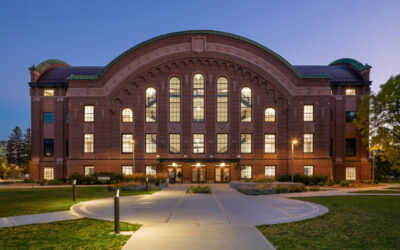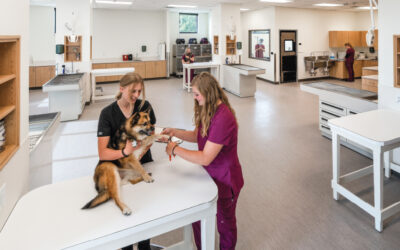Located in Spring Valley, CA and serving the greater San Diego area since 1992, A Glasco Inc. is a family-owned-and-operated company specializing in residential and commercial glass and glazing.
No matter the challenge of the job—whether a window repair, the installation of a shower enclosure, a storefront, a curtain wall, or the restoration of a landmark historic building—the company’s business philosophy remains constant: “We stand by our word.” And standing by that are customer reviews that confirm the company’s determination to go beyond expectations.
It was our pleasure to speak with Barry Livengood, A Glasco’s President and Founder, and his daughter Kristie Rehberger, General Manager, to learn more about the company, which, while celebrating its 30th anniversary, can still enjoy the benefits of Livengood’s 45 years of experience.
How it began
Following military service in Vietnam, Livengood interviewed for the position of manager of a glass company in Cincinnati. Asked by the owner what he knew about glass, he said, “It breaks!” Liking his answer, the owner replied, “You’re my man!” which led to eight years in the company’s management.
“I started backwards in the industry, as a manager, and then I went out in the field to learn the trade as I knew nothing,” Livengood admits. Eventually he returned with his wife and young family to his roots in the San Diego area and started his own glass business.
“I was working out of the backyard and started getting busy,” he recalls. “There was glass piled up all over the place, until one day my wife told me, ‘You have to find a place to work or stop this nonsense. So we moved to Spring Valley and opened a shop, but there were still lots of ups and downs.”
It seems, however, that there were more ups than downs because by 1999, A Glasco Inc. had been listed with the Better Business Bureau, achieved several certifications and accreditations, and enjoyed steady business with satisfied customers.
By 2001 it was attracting potential buyers. One “came in and offered me cash,” he recalls. “Kristie overheard and when he left, she looked disappointed and asked, ‘Are you serious about selling?’”
All three of his daughters had worked at the shop but until then he had no idea that any of them would be interested in taking over its management. He refused the offer, and today is glad of his decision and equally proud of his daughter, who, he notes, has taken the business to a new level in the last 21 years.
Kristie Rehberger is determined to make what she calls a good company into a great one, Livengood says, while remaining true to her father’s principles of putting customer service first and doing what you say you will do.
Good becomes great
Rehberger picks up the narrative. “I started working at age 16, sweeping, cleaning glass, answering phones, trying to help customers, and learning the business. My dad would take me into the shop, where our cutting table is, and show me how to handle and cut glass properly and explain the difference between types of glass; mirror vs. plate, tempered vs. annealed.”
Her opportunity to show what A Glasco could do came in 2003 when she decided to bid on the restoration and refurbishment of the 1,300-seat Balboa Theatre, built in 1924 in downtown San Diego as a movie palace and vaudeville venue.
Livengood recalls they went to look at it, and “her eyes got big, but I said, ‘No, no—restoration work is not what we need.”
Rehberger was determined, however, and prepared a bid which involved all customized work, including a storefront curtain wall with a rounded beauty cap, doors, and glass display cases, as well as replacement of the curved arched glass in the upper level where needed, along with aluminum frames.
When she and her father attended a meeting to submit the bid, there were few women in the room and certainly no one as young as Rehberger, who was in her early 20s. Instead of addressing her, the men questioned Livengood, to which he replied, “I don’t know, you have to ask her. She’s the one bidding on this,” he shares.
“She showed them the plans they were asking me about, and she answered all their questions. I think she shocked them and certainly won their respect.” The bid was accepted.
When the Balboa Theatre re-opened in 2008 as a venue for concerts, plays, and other live performance events, it garnered 16 awards. “After that, she started doing a lot of successful bidding, and it was soon noted in the construction business community that she was going to take over,” Livengood says.
Over the years, under Rehberger’s management, the company has successfully bid on commercial, residential, and public works projects. Some were major, including the largest one to date: a $1.5 million project at a retirement complex in Wesley Palms that included a storefront, apartments, a library, a fitness center, a pool, and solariums on the balconies. “We were so on schedule that the contractor had to tell us to back off because he wasn’t as far ahead as we were,” Rehberger says.
Another ambitious project in Carlsbad involved switching out blue reflective glass for green on a curtain wall consisting of at least 500 lengths of glass of different sizes. “We really had to figure out how to get that job done, taking on one section at a time and keeping everything straight from a project management and safety perspective. It was a big building for a company our size.”
The benefits, the challenges
There can be no doubt about the beauty that glass can add to a building. Architects love it, Rehberger says, because it enhances the exterior façade and floods the interior with natural light, beneficial to the people who spend most of their lives working indoors.
She cited case studies that show improved health benefits for both adults and children which have shown that natural light in the classroom can increase productivity by enhancing students’ ability to stay focused.
Another benefit is that triple-glazed glass, properly framed and installed, can help with sound reduction, mitigating the noise of jets taking off by as much as 75 percent. Because residential areas are so close to the airport in San Diego, the city has created a Quieter Home Project to benefit homes within a certain distance of take-off and landing areas, making homeowners in the affected areas eligible to receive funding to change out their windows for better noise reduction.
One huge challenge for glass installers is ensuring a watertight fit, something that can only be discovered after the windows are installed and have undergone a rigorous test of being sprayed at high pressure for 15 to 20 minutes. Rehberger recalls a hotel project which was split between three companies, with A Glasco doing the storefront on the main floor, and the other two doing a storefront on a balcony and the room windows above that, and only A Glasco’s installation passed the test without leakage.
“I felt extremely proud of my team. I’d created a PowerPoint presentation and gone over the installation instructions so they could understand both the fabrication and the installation. We worked hard to get the windows installed correctly according to the manufacturer’s guidelines and it was reaffirming, when we were the only ones to pass the test, to know that we were doing quality work.”
Another challenge all glass companies are dealing with is the concept of value engineering. Value engineering can be beneficial for the developer or building owner, when a contractor substitutes expensive finishes specified by the architect or designer, with less expensive ones, without compromising the integrity of the structure.
But when it comes to glass, value engineering may have detrimental effects on the success of the building. Rehberger serves on a committee of the National Glass Association which is examining the impact this is having on the glass industry as a whole.
“We’re finding that glass is one of those things being value-engineered out. Contractors may change the glass so it’s not as energy-efficient, or shrink the openings, and we’re working with glass companies to find solutions,” she says. “We’re also discovering some problems that could have been solved had we been involved in a project from the beginning. For a time, general contractors didn’t want to get involved with us early on, but recently there has been a move toward inclusion and asking for our input.”
Looking ahead for the industry
After 21 years as General Manager, Rehberger continues to be excited and enthusiastic about leading “a small business that punches above our weight,” while maintaining the value of superior customer service and satisfaction instilled in her by her father.
To this day Livengood says his greatest reward, “is seeing a customer’s smiling face and hearing, ‘I really like what you did.’ That’s what is truly rewarding.”
In the immediate future, Rehberger looks forward to being part of the San Diego Terminal 1 expansion and says she is working closely with the construction company that has been awarded the contract.
A Glasco has a Local Business Enterprise certification with the San Diego Airport Authority and for the past four years has been on-call to repair or replace glass at the airport. Before that, in 2013, the company replaced the glass in the existing air traffic control tower.
Rehberger’s interests, however, have expanded to embrace the wider community. In addition to her committee work with the National Glass Association, she is a board member of the National Association of Women in Construction, whose purpose is the betterment and education of women in the industry.
“It’s still common to be the only woman in the room. Women need the confidence to make sure their voices are heard and that they are equal players,” she says. She is currently organizing seminars that will help women business owners achieve the certifications they need.
Rehberger is also a founding member of the California Glass Association which is looking to address industry issues and train both women and men glazers. “We all need to understand what it takes to get the job done correctly the first time, and training is a huge part of that. We need more skilled labor and the lack has become a national issue. My hope is that the California Glass Association can bring other glass companies together to understand the problems and work on solutions for our industry,” she says.
“Our success at A Glasco is related to the success of all the other glass companies and we can’t succeed without one another. In fact, there are times when we depend on each other to see a project through. It may be borrowing labor, asking questions, or even having to purchase from one another,” says Rehberger.
“We are more tied together than a lot of us want to admit. Through this association, I hope to bring that to light so members recognize that everyone’s success matters. Companies are all independent, but we can still help each other get projects done.”













